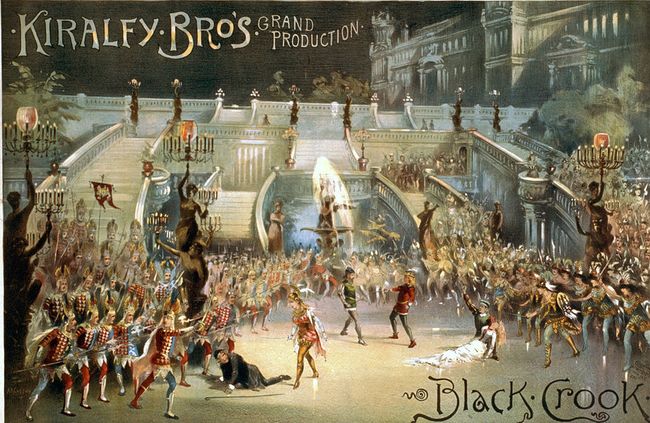Annotation:Black Crook Jig: Difference between revisions
No edit summary |
No edit summary |
||
| Line 1: | Line 1: | ||
{{TuneAnnotation | {{TuneAnnotation | ||
|f_annotation=[[File:BlackCrook.jpg|right|650px|thumb|The finale of The Black Crook (1866)]]'''BLACK CROOK JIG''' (2/4 time). American, Reel (2/4 time). E Major. Standard tuning (fiddle). AA'BB. The enormously popular and financially lucrative stage extravaganza ''' | |f_annotation=[[File:BlackCrook.jpg|right|650px|thumb|The finale of The Black Crook (1866)]]'''BLACK CROOK JIG''' (2/4 time). American, Reel (2/4 time). E Major. Standard tuning (fiddle). AA'BB. The enormously popular and financially lucrative stage extravaganza '''[[wikipedia:The_Black_Crook]]''' (1866) is said to have been the genesis of musical theatre in America, although it merely appropriated and packaged concepts around at the time in order to titillate and entertain. The five-and-a-half hour melodrama had music (mostly adapted) by Thomas Baker and, in America, was performed at Niblo's Gardens in New York City. It included elements of melodrama and fantasy (inspired in part by Carl Maria von Weber’s opera '''Der Freischütz''' and Goethe’s '''Faust'''), ballet (performed by a troupe of 100 French female dancers, in tights), spectacular scenery and costumes and transformation scenes made possible by sophisticated stage machinery. The play became astonishingly popular, achieving a run of 474 performances over the course of sixteen months and remained a mainstay of the American theatre until almost the end of the nineteenth century. In addition to the music written by Baker for the original production, there were many additional compositions written for interpolation later. | ||
<br> | <br> | ||
<br> | <br> | ||
Revision as of 14:50, 23 March 2021
X:1 T:Black Crook Jig M:2/4 L:1/8 R:George H. Coes B:Coes Album of Jigs and Reels, something new, for professional and amateur violinists, B:leaders of orchestras, quadrille bands, and clog, reel and jig dancers; consisting of a B:Grand Collection of entirely New and Original Clog-Hornpipes, Reels, jigs, B:Scotch Reels, Irish Reels and Jigs, Waltzes, Walk-Arounds, etc. (1876, p. 17) N:Coes performed with the San Francisco Minstrels in California from 1852 to 1859. Z:AK/Fiddler’s Companion K:E B/|eg/e/ {g}f/e/g/e/|(3e/e/e/ g/e/ z/B/G/B/|c/A/ z/c/ B/G/E/G/|F/f/{g}f/e/ f/a/g/f/| eg/e/ {g}f/e/g/e/|(3e/e/e/ g/e/ z/B/G/B/|1 c/Ac/ {c}B/G/E/G/|B/g/{a}g/f/ ez:|2 c/a/a/g {g}f/e/d/c/ B/b/a/f/ d/B/A/F/|| |:GG/E/ FF/E/|GG/F/ G/B/B/B/|(3e/e/e/ g/e/ {g}f/e/g/e/|a/f/g/e/ f/e/c/B/| GG/E/ FF/E/|GG/F/ G/B/z/B/|z/e/g/e/ z/B/G/B/|z/b/a/f/ ez:|]

The Black Crook became, during its months as a Broadway phenomenon, the butt of burlesque in virtually every minstrel and burlesque troupe in town. Christy’s Minstrels, the San Francisco Minstrels, Kelly and Leon (The Great Black Crook Burlesque) all featured parodies of the show, Tony Pastor offered John F Poole’s The White Crook and visiting British actor Edward Warden penned a Black Cook which went round the country.
"Black Crook Jig" was composed by blackface minstrel biography:George H. Coes.

